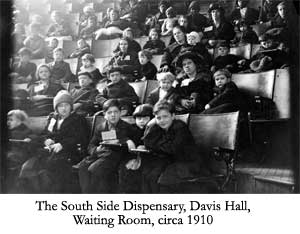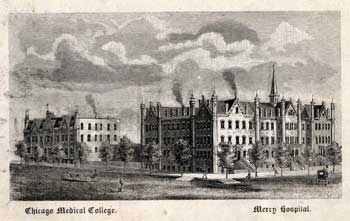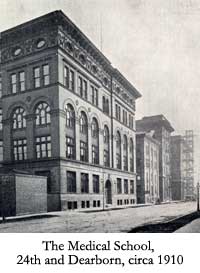By: Ron Sims, Special Collections Librarian
This article is part of the new exhibit, Photographing Pediatrics, which will begin mid-June in Dollie's Corner, on Level 2 of the Galter Health Sciences Library. The exhibit includes a pictorial history of the dispensary and clinics at Northwestern.
 In 1857, the Chicago City Dispensary, a charitable outpatient service, was opened. With the newly established medical college known as the Medical Department of Lind University in 1859, the dispensary became affiliated with the college.
In 1857, the Chicago City Dispensary, a charitable outpatient service, was opened. With the newly established medical college known as the Medical Department of Lind University in 1859, the dispensary became affiliated with the college.
The 1863 annual announcement of the medical college noted that “[t]he Chicago City Dispensary occupies a room in immediate connection with the College, and is attended by Professors Andrews and Byford.” During the years of 1862-1863, more than 8000 patients were prescribed for and treated in the dispensary. Professor Andrews gave a ‘Surgical Clinic’ in the lecture room every Wednesday during the school year, with patients selected from the dispensary. Professor Byford gave a ‘Clinic’ on diseases of women and children every Saturday.
After first relocating near the corner of State and 22nd Streets in 1864, the newly reorganized Chicago Medical College later became the Medical Department of Northwestern University in 1869, this time settling in a new building on the corner of Prairie Avenue and 26th Street.
 The 1871 annual announcement noted that the new Mercy Hospital building was situated on the same block of ground as the College Building. The free dispensary was relocated to small quarters in the basement of the hospital. The new location proved fortuitous after the Great Fire on October 9, 1871. The conflagration moved north through the city, leaving the hospital and medical college untouched.
The 1871 annual announcement noted that the new Mercy Hospital building was situated on the same block of ground as the College Building. The free dispensary was relocated to small quarters in the basement of the hospital. The new location proved fortuitous after the Great Fire on October 9, 1871. The conflagration moved north through the city, leaving the hospital and medical college untouched.
In 1872, the name was formally changed to the Davis Free Dispensary. The primary purpose of the dispensary, since its inception, was to provide medical services at no cost for the poor. Previous to this date, the dispensary was not used for teaching purposes; only selected cases were presented to medical students by the attending faculty in weekly ‘clinics.’
The 1873 announcement stated the Davis Free Dispensary “is an admirable complement of the Hospital in Clinical Instruction.” The dispensary was added as part of the regular curriculum and divided into six departments: medical, surgical, diseases of the chest, gynecological, ophthalmic, and skin diseases, with daily instruction for upper classmen. A group of six or eight students were present at operations and examinations, and witnessed treatment in each department. Each group remained about a week in each department successively. All the students had the opportunity for learning the practical use of the laryngoscope, ophthalmoscope, speculum, and all the instruments used in the departments of the dispensary.
One or more of the advanced students were also employed in each department as assistants. The dispensary classes did not interfere with the regular hospital clinics, but corresponded with the ‘Private Courses’ of medical education institutions in the East and Europe. The Mercy Hospital Ticket [fee] admitted students to the dispensary as well as the hospital clinics.
In 1874, the number of patients that attended the dispensary was nearly 7,800. The faithful attention given by the medical staff and the absence of other dispensaries on the south side also contributed to the success of the dispensary from its very foundation. The expenses were relatively great, but through a board of trustees, a $3000 gift each from Drs. N. S. Davis and W. H. Byford with a like sum obtained from the Chicago Relief and Aid Society, formed an endowment to subsidize the dispensary. After much supplication, $600 was given by the Board of Cook County Commissioners. In 1875 the faculty of the college agreed to appropriate annually for the maintenance of the dispensary a sum of money not to exceed $500. The funds that the trustees secured were carefully invested and wisely used for the continuing operation of the dispensary.
On September 16, 1875, the name of the dispensary was changed from the Davis Free Dispensary to the South Side Dispensary.
In 1882, Dr. Davis met with the trustees and advised placement of each department of the dispensary under immediate charge of the faculty of the Chicago Medical College who would be responsible to the dispensary organizers and board of trustees for the service in each department. The motion was adopted, and the college faculty assumed the medical control of the dispensary.
In July 1892, the trustees of the South Side Dispensary resolved that the reorganization and future management of the dispensary be entrusted to the executive committee of the faculty of Northwestern University Medical School. This would be on condition that the dispensary should be conducted in such manner as to afford the greatest amount of medical and surgical aid to the actual poor, and also afford the most efficient clinical instruction to the students. The dispensary, originally organized apart from the medical school became an integral and indispensable part of Northwestern University.
The board of trustees continued to assume its financial control until May, 1893, when the trustees agreed to appropriate $10,000 held by investment for income to pay current expenses to aid in the construction of the new campus on Dearborn Street, on condition that the South Side Dispensary be furnished with sufficient room and accommodations for the legitimate work of the dispensary in a new building. Another condition was that Northwestern University Medical School appropriate $500 annually for the necessary expense of medicine and supplies in the dispensary.
In the summer of 1893, Davis Hall was erected, fulfilling the pledge of a new building for the dispensary trustees. Constructed specifically as an outpatient hospital, it contained the most modern accommodations of any institution of its kind in the country. Between twenty-four and twenty-five thousand patients were treated annually. There were nine departments: medicine, surgery, neurology, orthopedics, gynecology, laryngology & rhinology, dermatology & syphilology, ophthalmology & otology, and pediatrics. Each department occupied a separate room, or suite of rooms, and a clinical instructor was responsible for each.
 By 1902, the annual announcement noted the abundant and rich clinical material which permitted the faculty to give each medical student a great amount of individual instruction. The curriculum had been reorganized from three to four years. The junior and senior classes were subdivided as before in sections of eight or ten and were assigned one month in the different departments of the dispensary. Attendance and efficiency of work in the dispensary became as essential to graduation as were the requirements in laboratory or didactic courses.
By 1902, the annual announcement noted the abundant and rich clinical material which permitted the faculty to give each medical student a great amount of individual instruction. The curriculum had been reorganized from three to four years. The junior and senior classes were subdivided as before in sections of eight or ten and were assigned one month in the different departments of the dispensary. Attendance and efficiency of work in the dispensary became as essential to graduation as were the requirements in laboratory or didactic courses.
The dispensary provided students their first practical work in medicine: meeting the patient, developing a history of the patient's illness, making careful physical examination, deliberation as to diagnosis and in a discussion with the physician in charge, differentiations from similar conditions that might lead to error and learning to eliminate the nonessential from the important. The training in the dispensary continued daily for two years, developing the qualities that make the good diagnostician: an abundance of material, a large experience, much observation, exercise of tact, deliberate judgment, and a growing confidence in the student’s ability, with a true appreciation of the student’s limitations.
In 1903, a diet kitchen was installed in which students learned the practical dietetics of infant feeding, a first in Chicago. X-ray service was added in 1917. Social service was instituted in 1920 and a prenatal clinic in 1922.
The rest of the story will be told in an upcoming issue of Library Notes.
Updated: March 5, 2020